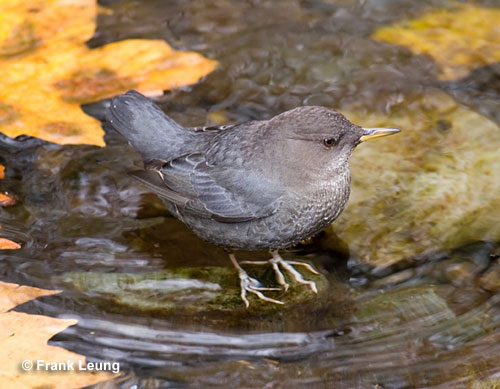American Dipper (Cinclus mexicanus) is a fairly common songbird, usually found near rivers, streams, and at the edge of montane lakes.
If you see a round, dark gray bird standing on a rock in a rushing mountain stream, you have probably found an American Dipper! This interesting little bird is a fairly common resident in appropriate habitat within its range.
Have you ever wondered how you can see an American Dipper? See this article to learn all about this aquatic songbird!
On this page
Identification
The male American Dipper is a chunky, dark gray songbird with hints of dark brown plumage on its head and neck. On average, they are 7.5 inches long, have an 11-inch wingspan, and weigh two ounces. This bird also has small pale markings above and below its eyes. These markings are more obvious when the dipper blinks.
Male American Dippers also have long pinkish legs with fairly large feet. I’ve noticed, that in cold water, their legs can sometimes seem to be bright pink! They use their long legs to walk on slippery river rocks both above and below the surface.
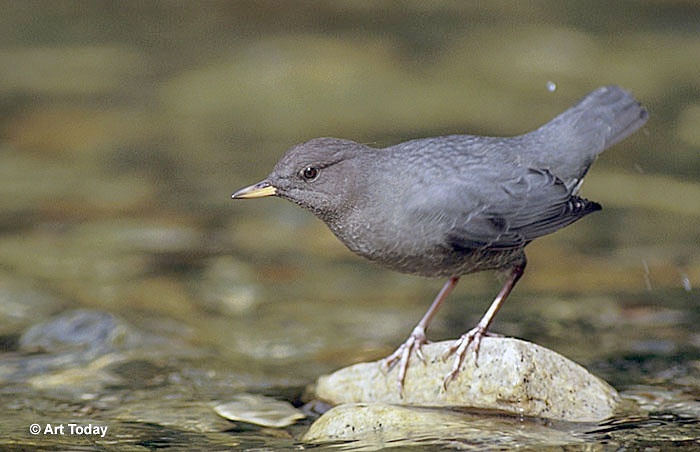
Female American Dippers look just like male birds but tend to be a little bit smaller and weigh less. However, these differences between the sexes can overlap and are impossible to tell in the field.
Like males, female dippers can show some pale edging to the feathers in their wings and undertail. Female and male birds have short, squared tails that they often hold cocked up, and straight, black, somewhat flattened beaks.
They use their fairly short, rounded wings for direct, buzzy flight that follows the courses of the streams and rivers they live on.
Juveniles resemble adults but have paler beaks and more white markings in their plumage.
Vocalizations
American Dippers sometimes make loud and abrupt, buzzy calls. Both sexes make these vocalizations while foraging. Males and females also sing a loud and complex song, usually while perched on a rock in the middle of a stream. They sing most often in late winter and spring, and are much quieter during the summer months.
I often find the boulders American Dippers sing from by looking for river rocks that have lots of “whitewash” or white bird droppings.
Their song consists of several, varied and repeated phrases and trills. It reminds me of a mockingbird and sounds like, “jit jit jit, zhree zhree zhree, sree sree sree, chur chur chur, jit jit jit…”
Food
American Dippers mostly feed on aquatic insect larvae, various aquatic insects, and other food items they find in cold, rushing water. For example, they also eat fish eggs and even small fish.
This bird eats most types of insects it manages to catch. Many of those insects are the larvae and adults of caddisflies, stoneflies, other types of flies, and mosquitoes. They also eat a fair number of aquatic beetles, and can take advantage of fish spawning events to feed on fish eggs.
Some of the fish that American Dippers catch include baby trout and even baby salmon. They often forage and do so in a few different ways. American Dippers can wade into water and pick insects from the surface, or lower their head underwater to look for nearby prey. If they see an insect, they pick it up with their beak.
These aquatic birds can also dive underwater for 15 seconds, and frequently walk underwater to search for hidden bugs. While they are underwater, dippers can swim after small fish but mostly use their beaks to probe under rocks and other places where insects hide.
They can also forage near ice, at the edge of a stream, and use their beak to pick through detritus.
Nesting and Eggs
American Dippers form pairs in late winter and early spring. They start building their nest a week or two later, mostly from to April but sometimes in May. Both sexes bring moss and grass to help construct the nest on the ledge of a cliff, large boulder, bridge, or other structure next to the water. They can also build their nest behind a waterfall or on a riverbank.
Most importantly, they choose nesting sites that won’t be flooded while also helping to protect the nest from predators. For this reason, they often construct nests above deep water, rushing water, and on sheer cliffs.
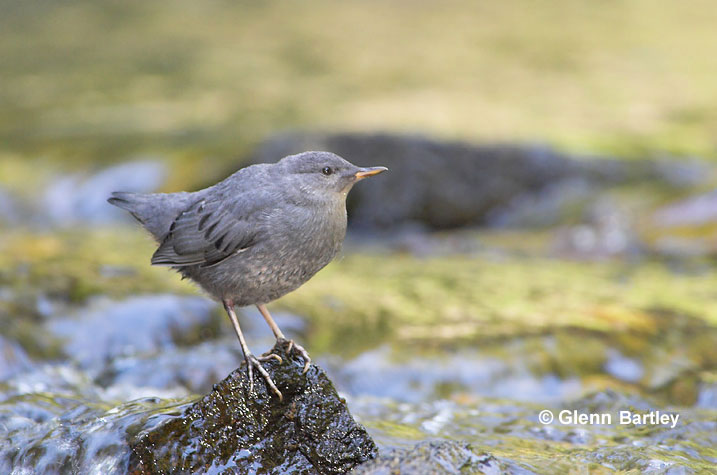
They make a well-insulated cup nest with a domed structure that helps protect it from rain and splashing water. Once the nest is finished, the female dipper lays 5 plain white eggs nearly one inch long each. She incubates them for 14 to 17 days, and her mate helps by bringing her food.
After hatching, both parents feed the babies in the nest for 25 days. They bring them all sorts of aquatic bugs and other food items but mostly feed them flying insects.
The baby birds continue to be fed by their parents for a week or even a month after leaving the nest.
Current Situation
American Dipper habitat includes cold, clear rivers, streams, and montane lakes. In winter, as long as the water doesn’t freeze over, they live in the same habitats and can also use estuaries.
This species is a permanent resident in Alaska, western Canada, and many parts of the western USA. It also lives on clear, mountain waterways from Mexico to western Panama.
The American Dipper is listed as Least Concern in the IUCN Red List and is a fairly common bird in most of its range.
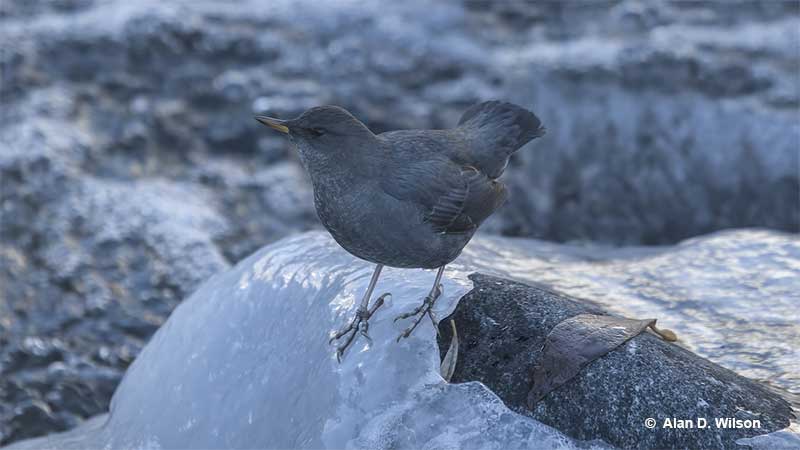
This species is not threatened and an estimated 130,000 birds live in Canada and the USA. They seem to have a stable population but can be locally affected by deforestation that causes erosion of riverbanks and muddy water. American Dippers can also be susceptible to dams and pollution that affect water quality.
However, in most places, they are fairly common birds and can also use nest boxes placed on bridges and other riverside structures.
Facts
- Compared to many other songbirds, the songs and calls of American Dippers are much louder. Even nestling dippers make frequent, loud calls. Such loud vocalizations are a common attribute of birds that need to be heard over the constant noise of rushing water.
- To communicate in their loud environment, American Dippers also use non-vocal behaviors. They move (or “dip”) their bodies up and down, and blink their eyes to flash their white eyelids.
- To keep them warm while diving in cold water, American Dippers have extra thick plumage including feathered eyelids! These hardy birds also have reduced metabolism and their blood can carry more oxygen.
- The American Dipper has a flap of skin that covers its nostrils as it forages underwater.
- There aren’t too many predators that catch American Dippers. However, they are occasionally preyed on by hawks, Great Blue Herons, and even large trout.
Similar Species
Very few if any species are confused with the American Dipper. This distinctive bird is the only aquatic songbird in its range. However, there are a couple birds that might look a bit similar.
Gray Catbird
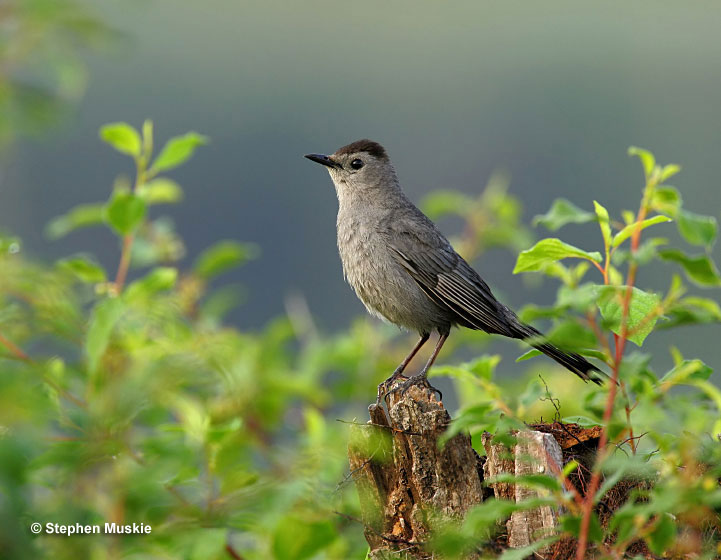
This species has gray plumage like the dipper and also has a straight black beak. However, unlike the rotund dipper, Gray Catbirds are slender birds with a long tail and a reddish undertail. They also live in brushy habitats and not on western streams and rivers.
Rock Sandpiper
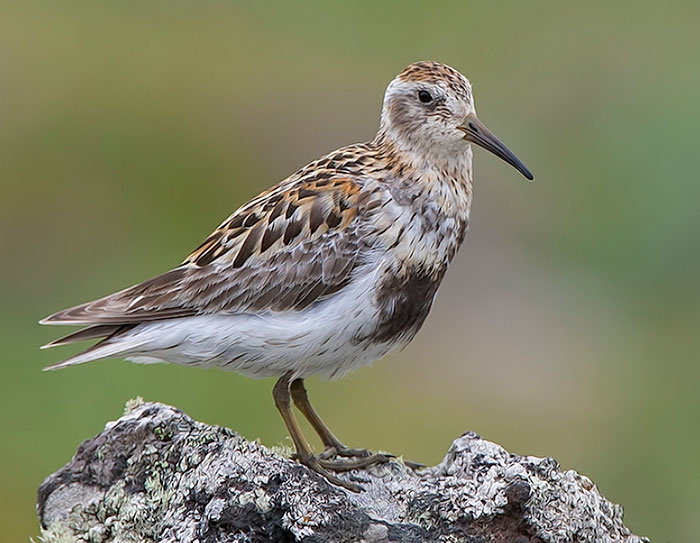
Similarly to American Dipper, Rock Sandpipers have similar gray upperparts and, in the winter, can occur with American Dippers on rocky Pacific coastlines. However, they are a bit bigger, and have a longer beak with a pale base. The sandpipers also have greenish legs and spotting on pale underparts.
Frequently Asked Questions
Why do American dippers bounce?
American Dippers bounce to communicate with each other. They may also move up and down to try to blend in with rushing water, or to help them see prey on and under the water.
Can the American Dipper fly?
Yes, the American Dipper can fly. This bird flies along streams and rivers with rapid wingbeats and glides.
Where does the American Dipper live?
The American Dipper lives on clear clean streams, rivers, lakes, and other waterways in western North America. It occurs in many mountainous regions including from Mexico to western Panama.
What do American Dippers eat?
American Dippers eat lots of aquatic insects, fish eggs, small fish, tadpoles, and other small aquatic creatures.

